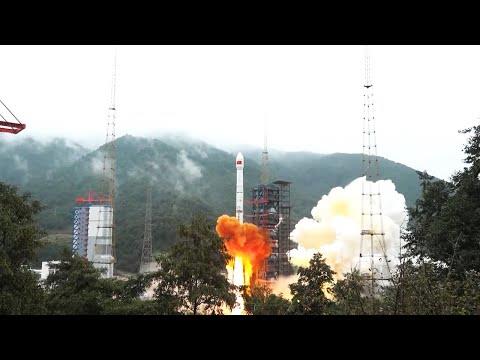(MENAFN- Asia Times) Does China's alleged satellite crusher, Shijian-21, have a Mini-Me in space orbit, that is paralleling its movements?
China claims it is nothing more than a debris mitigation satellite, but with an obvious military dual purpose, and now, a wingman at its behest, new questions are being raised.
According to SpaceNews.com , US space tracking has detected a mystery object orbiting along with China's recently launched Shijian-21.
Mini-Me, of course, was a character played by Verne Troyer in the second and third Austin Powers comedic spy films.
Shijian-21 was launched into geosynchronous transfer orbit Oct. 23 by a Long March 3B rocket. Chinese state media reported that the satellite would“test and verify space debris mitigation technologies,” but no further details have been revealed.
The Shijian-21 spacecraft was developed by the Shanghai Academy of Spaceflight Technology (SAST). SAST in September unveiled a“supplemental service spacecraft” concept at the Zhuhai Airshow.
On Nov. 3 US Space Force's 18th Space Control Squadron (SPCS) catalogued a new object alongside Shijian-21 with the international designator 2021-094C.
The object is noted as a rocket body and more precisely an apogee kick motor (AKM), used in some launches for a satellite to circularize and lower the inclination of its transfer orbit and enter geostationary orbit.
Apogee kick motors usually perform a final maneuver after satellite separation so as to not pose a threat to active satellites through risk of collision. However both Shijian-21 and the SJ-21 AKM are side by side in geostationary orbit.
It is currently unknown whether the mystery object is an AKM, an object possibly related to space debris mitigation tests, or part of potential counterspace operations tests.
The object could be used to test rendezvous and proximity operations, refueling experiments or manipulation using a robotic arm or other means.
Given the lack of transparency the activities of Shijian-21 and its companion are likely to be closely tracked and scrutinized.
The commander of the US Space Command, Air Force Gen. James Dickinson told Congress in April that spacecraft like the Shijian-21 is part of an effort by China to seek“space superiority through space and space-attack systems.”

“One notable object is the Shijian-17, a Chinese satellite with a robotic arm,” Gen. Dickinson said.“Space-based robotic arm technology could be used in a future system for grappling other satellites.”
Gen. Dickinson said the co-orbital robotic spacecraft is part of a growing arsenal of space weaponry fielded by the Chinese military.
“All the while, China continues to maintain their public stance against the weaponization of space,” he claimed.
Michael J. Listner, a space security analyst, said identifying China's capabilities is difficult because of the dual-use nature of space technology.
“Technology that has peaceful uses can be used for nonpeaceful uses,” he said.
“A mission that could have a peaceful use in orbital debris mitigation could be employed as a co-orbital ASAT (Anti-satellite weapons),” said Listner, with the firm Space Law and Policy Solutions.
China “says 'trust us,' but the classified nature of the mission and the PRC's development of counter-space capabilities says otherwise.”
Shijian-21 also follows complex maneuvers carried out in geostationary orbit by other Chinese test satellites in recent years.
China's TJS-3 (Tongxin Jishu Shiyan-3) satellite launched in 2018 released a payload of unstated purposes.
The pair maneuvered in concert and carried operations including spoofing, which involves coordinated maneuvers at certain times in an attempt to confuse rivals' space tracking networks.
The activities take place in a context of growing tests of counterspace and clandestine activities in geostationary orbit by China, the US and Russia.
An Oct. 28 article published by Breaking Defense highlights some of these activities using videos from commercial space situational awareness company COMSPOC.
These include USA 271, a space surveillance satellite,which approached China's large Shijian-20 satellite and Russia's Luch/Olymp approaching to within 1.8 kilometers of a US commercial satellite.
Against this backdrop Lt. Gen. B. Chance Saltzman, US Space Force deputy chief of space operations for operations, cyber and nuclear, suggested Nov. 3 that hotlines could be established with foreign rivals to reduce the risk of an accident or miscalculation triggering conflict, as have been set up previously in other domains and crises.
“I don't see any reason why a similar approach couldn't work for the space domain,” Saltzman said.
The nature of the Shijian-21 and the companion“AKM” will likely become more apparent over time, such as if and when the spacecraft maneuver and the nature of any changes of orbits and if these are coordinated.
A maneuver by the SJ-21 AKM would indicate an active rather than passive object.
Sources: SpaceNews.com, Breaking Defense, SpaceFlightNow.com, NASA
MENAFN07112021000159011032ID1103117193
Legal Disclaimer:
MENAFN provides the information “as is” without warranty of any kind. We do not accept any responsibility or liability for the accuracy, content, images, videos, licenses, completeness, legality, or reliability of the information contained in this article. If you have any complaints or copyright issues related to this article, kindly contact the provider above.